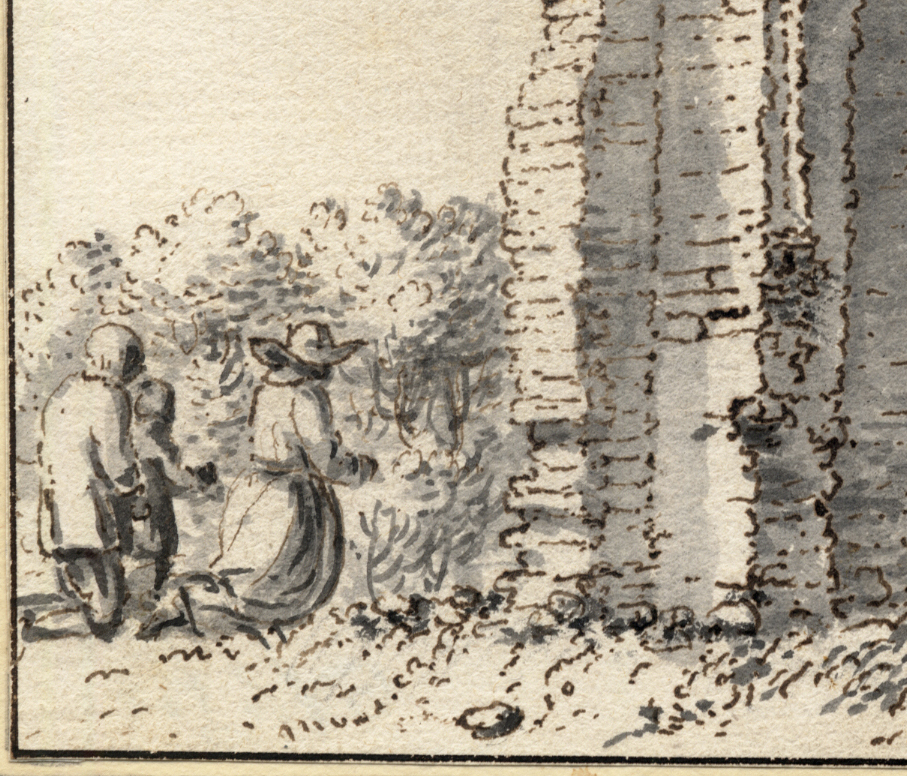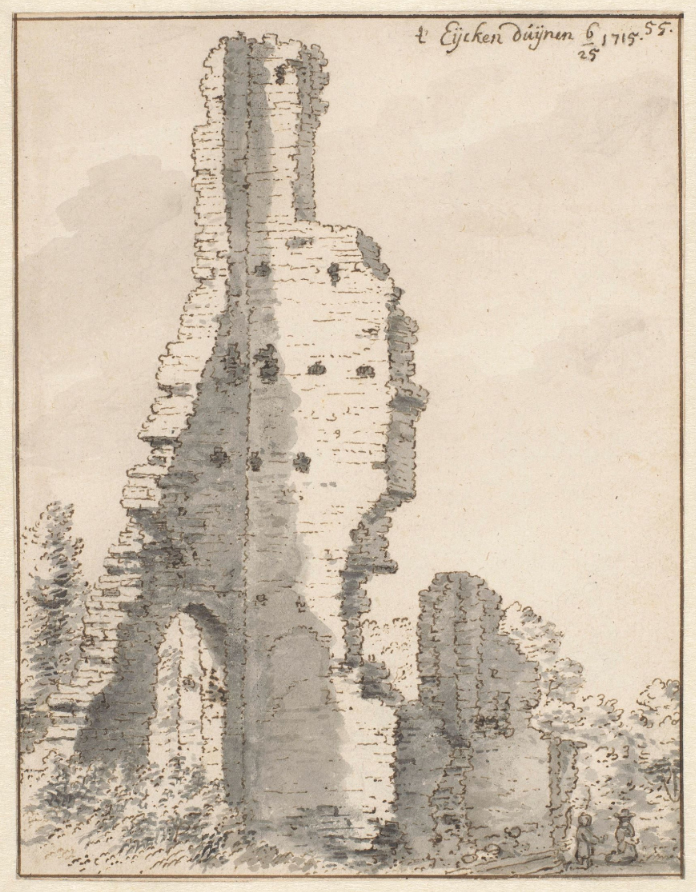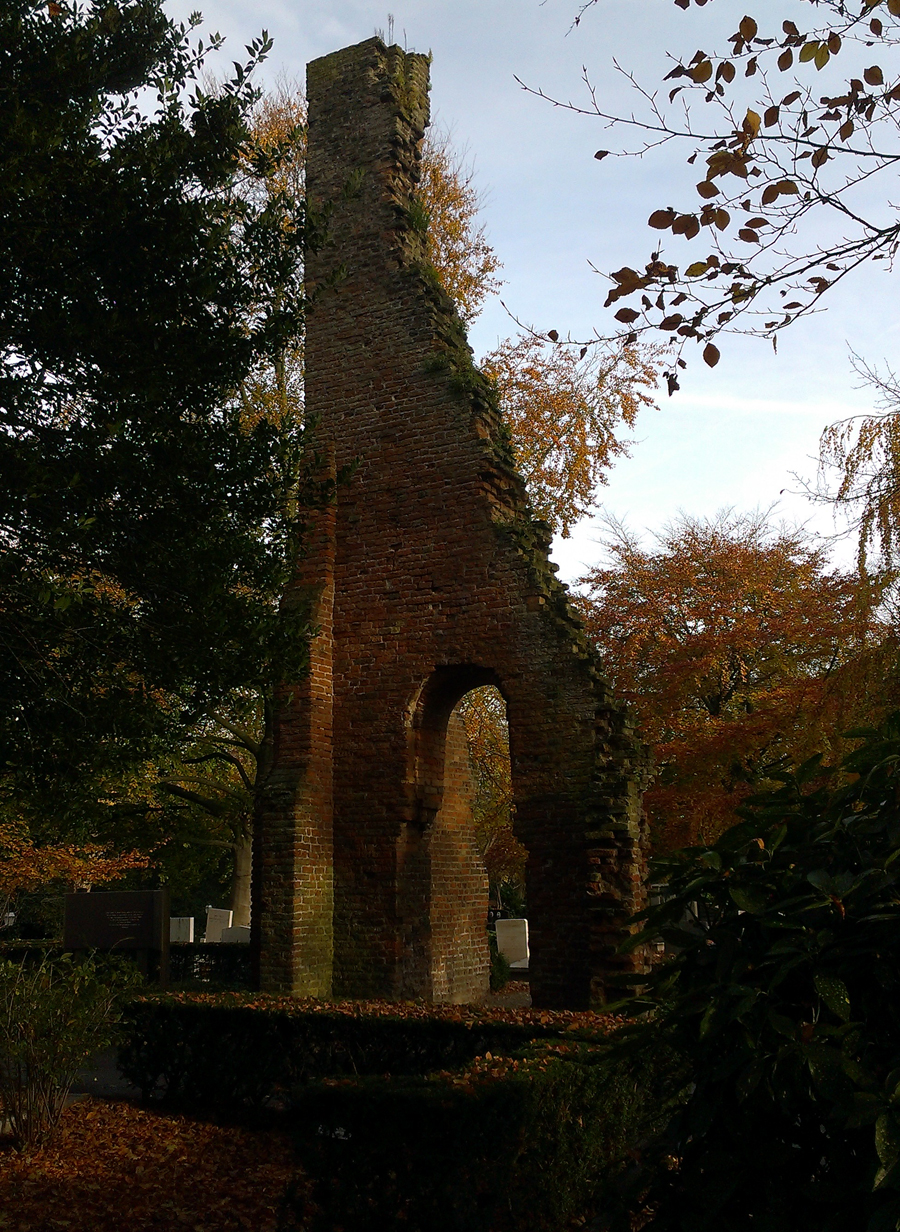VALENTIJN KLOTZ (Maastricht c. 1650 – 1721 The Hague)
Valentijn Klotz (Maastricht c. 1650 – 1721 The Hague)
View of the Ruined Church at Eikenduinen
Pen and brown ink, grey wash, black ink framing lines, partial watermark crown, 196 x 152 mm (7.7 x 6 inch)
Inscribed and dated ‘Eijcken Dúijnen de 6m/25d 1715.’ (brown ink, upper right); numbered ’56’ (brown ink, upper right); inscribed ‘Z11’ and ‘A.g.H. 1824 / Klotz’ (pencil, verso); the mount inscribed ‘Begraafplaats tusschen Leiden en ‘S Hage 1715. Clots’ and numbered ‘No. 30’ (pencil)
Provenance
~ Possibly Johannes Enschedé, Haarlem; his sale, Jelgersma, Van de Vinne, Haarlem, 30 May 1786, Album G, no. 365: ‘Eikenduinen; door Klots 1715.’ (sold fl. 1:10)1
~ Private collection ‘Monsieur J.J.S.’, Paris, until 2014 (his mark in blue ink on the verso)
***
Valentijn Klotz’s oeuvre mostly consists of topographical drawings, many inscribed with the date and place they were made, such as is the case with the present sheet.2 From 1672 to 1676 Klotz accompanied the ‘Staatse leger’, the army of the Dutch Republic commanded by the Stadtholder-King William III, in its campaigns against Louis XIV of France, who was invading the Southern Netherlands. Many drawings were done during this adventurous period of places where the army was stationed; they were partly of strategic value, recording places of interest for future military expeditions.
Later in life Klotz drew views of The Hague, where he had settled. His carefully delineated drawings have much in common with those of Contantijn Huygens II (1628–1697) and Josua de Grave (1643–1712), who also recorded the exploits of the Dutch army. Klotz’s drawings are very similar to those by De Grave, but are livelier and artistically more sophisticated - they can also be distinguished by Klotz’s distinctive handwriting.3
The present well preserved drawing, executed on 25 June 1715, was done in Klotz’s old age, when he had settled in The Hague. The ruin of the church of the village of Eikenduinen, between The Hague and Loosduinen, must have been a favoured destination for Klotz, as he drew it on more than one occasion, mostly during the summer months.
A sheet executed on the same day as our drawing, showing the ruin from a different angle, is preserved in the Rijksprentenkabinet, Amsterdam (fig.).4 Klotz drew further views of the ruin on 24 August 1717 (Rijksprentenkabinet, Amsterdam)5 and 5 July 1718 (municipal archives, The Hague).6
The chapel in Eikenduinen was founded by Willem II between 1234 and 1256 in memory of his father, Count Floris V, and was dedicated to the Virgin.7 Elevated to parish church in 1331, the chapel contained a relic of the Holy Cross, and attracted pilgrims. The chapel was destructed after the Reformation in 1581, but its ruin remained a source of veneration to Catholics from The Hague well into the eighteenth century. In our drawing, Klotz has included three pilgrims praying. The ruin survives to the present day more or less as Klotz drew it in 1715 (see last fig.).
SOLD
1. The entry must refer to either our drawing or the similar view in the Rijksprentenkabinet, dated to the same year.
2. For Klotz as a draughtsman, see M. Breitbarth-van der Stok, ‘Josua de Grave, Valentinus Klotz en Bernardus Klotz’, Bulletin van de Koninklijke Nederlandse Oudheidkundige Bond 68 (1969), pp. 93-115. For examples of the handwriting of Valentijn Klotz, Bernardus Klotz and Josua de Grave, see J.H. van Mosselveld and W.A. van Ham, Tekeningen van Bergen op Zoom, Bergen op Zoom 1973, p. 16.
3. E. Haverkamp-Begemann a.o., Fifteenth- to Eighteenth-Century European Drawings: Central Europe, The Netherlands, France, England, The Robert Lehman Collection VII, New York 1999, p. 286.
4. Pen and brown ink, grey wash, 198 x 152 mm; inscribed and dated ‘t Eijcken dúijnen 6/25 1715.’ And numbered ‘55’; inv. no. A2888.
5. Pen and brown ink, grey wash, 197 x 150 mm; numbered ‘74’; inv. no. A2889.
6. Breitbarth-van der Stok, op. cit., p. 107, fig. 32.
7. See Charles Dumas, Haagse stadsgezichten 1550-1800, Zwolle 1991, pp. 212-18. Other artists to depict the ruin included Anthony van der Croos, Willem Buytewech, Jan van Goyen, Albert Cuyp and Jan de Bisschop.





